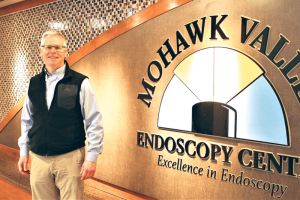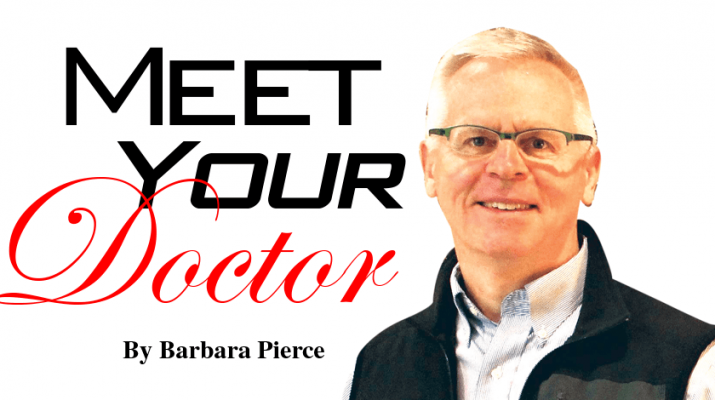Emil Miskovsky recently joined the Digestive Disease Medicine group and is performing procedures at Mohawk Valley Endoscopy Center as a gastroenterology specialist. MVEC is the Mohawk Valley’s first licensed ambulatory surgery center specializing in outpatient colonoscopies and upper gastrointestinal endoscopies. MVEC is a collaborative effort of Digestive Disease Medicine, Faxton-St. Luke’s Healthcare and St. Elizabeth’s Medical Center in Utica.
By Barbara Pierce

Q.: The Mohawk Valley Endoscopy Center is designed specifically to perform outpatient endoscopy procedures. In addition to colonoscopies, the other primary procedure you perform is upper gastrointestinal endoscopies. Can you tell us more about this procedure?
A.: Gastroscopy, or upper endoscopy, is the other procedure we commonly do here. An upper endoscopy is a procedure that allows us to diagnose, and sometimes treat, conditions that effect the esophagus, stomach and beginning of the small intestine.
We are able to directly visualize the inside lining of the upper GI tract using high-definition fiber-optic scopes that are smaller than a ½-inch in diameter.
Q.: Why would a person need this procedure?
A.: If a person is having difficulty swallowing, abdominal pain, heart burn, regurgitation, gastrointestinal bleeding, or nausea and vomiting, an endoscopy will help me determine what is causing these symptoms.
During the procedure, I collect tissue samples (biopsies) to test for diseases and conditions, such as anemia, bleeding, inflammation, diarrhea, or cancers of the digestive system.
Also, I can pass special tools through the endoscope to treat problems in your digestive system — widen a narrow esophagus, clip off polyps or remove a foreign object. I can stretch a narrow area with balloons, as well as inject Botox. If the patient has cancer of the esophagus, I put in a stent to keep a blocked area open. If there is active bleeding, we can use cautery or clips to stop it.
Q.: What does this procedure involve?
A.: The endoscopy procedure takes only five to 10 minutes. The only preparation required is to eat nothing for 12 hours prior to the procedure.
During the procedure, the patient lies on his or her left side and is anesthetized. Propofol is the anesthetic that is generally used. I use a flexible endoscope to go into the esophagus or stomach and take biopsies.
I remove the scope, the patient wakes up, and we talk about what I have found.
Q.: Are these symptoms that cause a need for an upper endoscopy fairly common?
A.: Yes, they are a very common occurrence these days and they are increasing.
Q.: Why are they becoming more common?
A.: That’s a good question. One reason is that these symptoms may be caused by food allergies, and food allergies are on the upswing, like gluten sensitivity. Another allergic condition is called eosinophillic esophagitis. This condition can cause difficulty swallowing, nausea, or abdominal pain.
There is an intense interest in proving why there are more food allergies today compared to 30 years ago. It may have to do with the preservatives in our food.
Food allergies are treatable by eliminating the food you’re allergic to. Alternatively, the symptoms can be treated with steroids or other medications.
Q.: How did you become involved in this specialty?
A.: I’ve always enjoyed seeing a wide variety of patients, young as well as old. I’ve always been interested in being able to help people through diagnosis and treatment.
I find the field of gastrointestinal medicine intriguing. It has a solid foundation in physiology and pharmacology, and now molecular biology. There is a great diversity of conditions I diagnose and treat. I’ve had extensive training and experience in the diagnosis and treatment of conditions that affect the esophagus, stomach, small intestine, colon, liver, bile ducts and pancreas.
There’s a diverse array of conditions involved, like inflammatory bowel disease, chronic and acute liver diseases and cancer of the organs.
Understanding causes of metabolic disorders such as iron overload (hemochromatosis) has led to accurate diagnosis and preventive therapy. Colonoscopy screening has decreased rates of colon cancer in the United States in my lifetime and this is very gratifying.
Q.: Why did you choose the Mohawk Valley for your practice?
A.: I’m somewhat familiar with this area as I went to Albany Medical College. I have close family in the Adirondacks and I visit often. I like to hike and fish — this is a great area for that. And, over the years, I’ve met and gotten to know these doctors I now work with. I know they run an excellent program and they’re great doctors.
Q.: What else would you like people to know about you or MVEC?
A.: It’s a good idea to get colon cancer screening, and I encourage everyone to be screened. Screening is a form of prevention, not just detection, as polyps that may turn into cancer are removed during the procedure.
Also, I’d like people to be aware of a condition called Barrett’s esophagus. It’s associated with acid reflux and is increasing in frequency, especially for white males over 50. It increases your risk of developing esophageal cancer.
Rates of esophageal cancer are increasing unfortunately. If you have a hiatal hernia or you smoke, you’re at risk to develop this cancer. So it’s important to be screened.
Lifelines
Current residence: Utica
Education: Bachelor of Arts degree, Dartmouth College, Hanover, N.H.; medical degree, Albany Medical College; residency in internal medicine and immunology, Georgetown University Hospital, Washington D.C.; fellowship in gastroenterology and hepatology, John Hopkins Hospital, Baltimore, Md.
Hobbies: The outdoors: hiking, skiing, and fly fishing in the Adirondacks

